Key takeaways:
- Post-production enhances storytelling by refining visuals, sound design, and color grading, significantly impacting audience perception.
- Collaboration with professionals, such as colorists and sound designers, can elevate the quality of a film, offering new insights and creative solutions.
- Essential software like Adobe Premiere Pro and DaVinci Resolve are crucial for effective editing and color grading, enabling filmmakers to unleash their creative potential.
- Organization and continuous learning are vital for optimizing resource use, ensuring a smoother and more efficient post-production process.
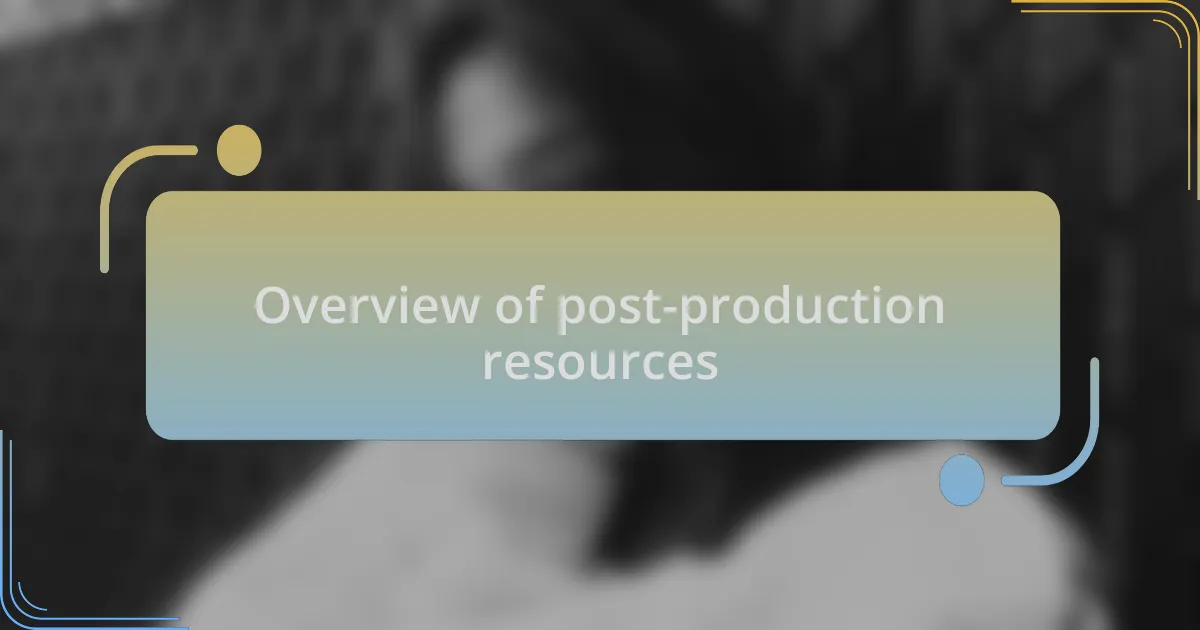
Overview of post-production resources
Post-production resources are essential tools that transform raw footage into a polished final product. I remember the first time I sat in an editing suite filled with software and hardware options; it felt overwhelming yet exhilarating. It made me realize how vital these resources are, not just for editing, but also for sound design, color grading, and visual effects.
Often, filmmakers underestimate the impact of sound and music in post-production. Have you ever watched a scene that didn’t resonate emotionally due to poor sound quality? I have, and it highlighted how sound design can elevate the narrative. When we use high-quality audio resources alongside video editing tools, we create a more immersive experience for our audience.
Moreover, collaboration with skilled professionals can significantly enhance the post-production process. I always find it enlightening to work with a colorist who sees the narrative through a different lens. It’s incredible how professional insights can lead us to choices we wouldn’t have made on our own, ultimately elevating the final piece.
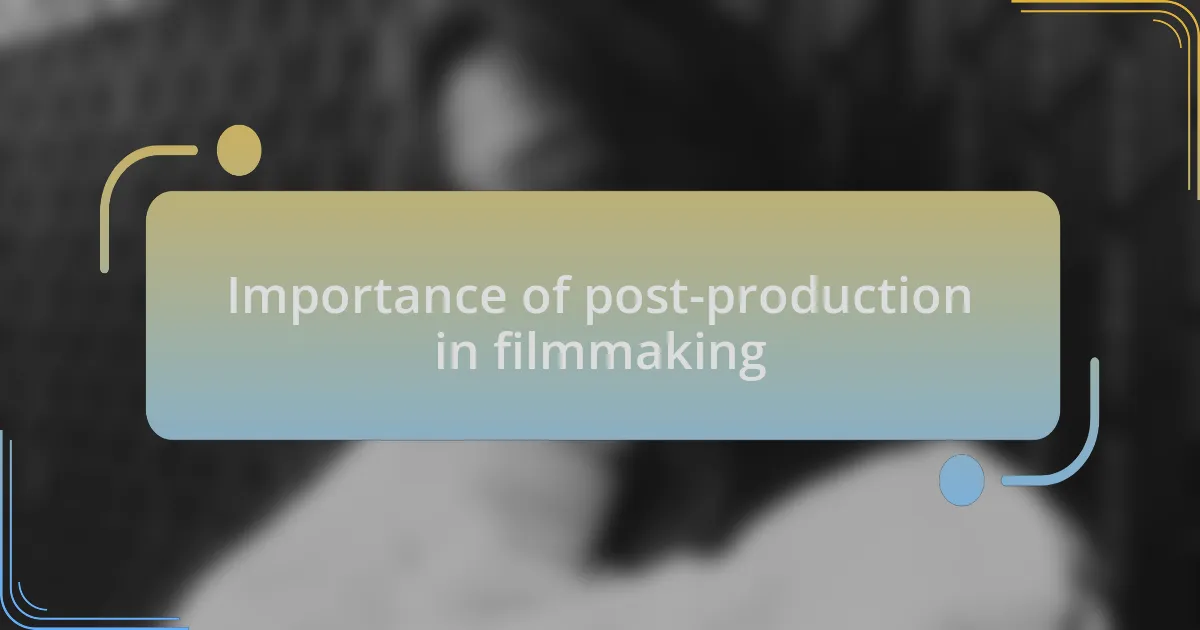
Importance of post-production in filmmaking
Post-production is where the magic truly happens in filmmaking. I remember a particular project where I thought a scene was complete, but once it hit the editing room, it transformed entirely. The pacing, the cuts, and the addition of ambient sound made that moment leap off the screen—it taught me that this phase is not just about finishing touches, but rather an opportunity to reimagine the story.
Furthermore, it’s fascinating how subtle changes during post-production can profoundly impact the audience’s perception. I’ve witnessed shots gain new life through color grading, shifting the entire mood of a scene with just a few adjustments. Isn’t it amazing how a simple tweak can alter the emotional weight a moment carries? It’s moments like these that reinforce the importance of refining the film in its post-production phase.
Finally, the importance of post-production extends beyond technical skills—it’s about storytelling continuity. I recall an instance where a story beat didn’t quite connect in dailies but flourished in the final cut. Engaging in post-production not only polishes the film but also ensures that every narrative thread is cohesive, ultimately crafting a seamless experience for viewers to enjoy.
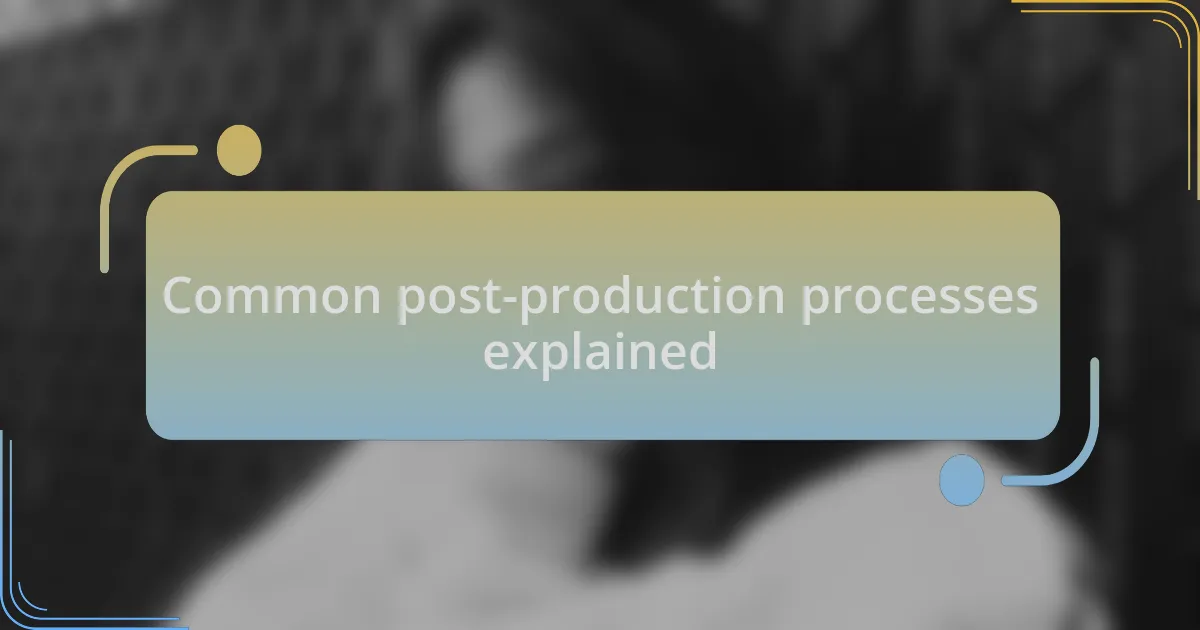
Common post-production processes explained
When we dive into the editing process, it’s like discovering a treasure chest of potential hidden within raw footage. I distinctly remember sifting through hours of clips from a documentary I worked on, and the act of trimming and rearranging them sparked ideas I hadn’t initially considered. It’s incredible how some cuts had to be made simply for the rhythm—not just for the story itself. Have you ever experienced the thrill of finding the perfect cut that not only enhances pacing but evokes a visceral emotional response?
Another crucial post-production process is sound design, which I find often goes underappreciated. In one project, I was amazed how adding layers of sound—like the rustling of leaves or subtle background chatter—elevated the scene’s realism. It’s not just about what the audience sees, but also what they hear. This element can envelop viewers in the film’s world, and I often think: Isn’t sound the unsung hero of storytelling?
Color grading can feel like painting with emotions, and I’ve learned that a well-graded scene can evoke unexpected feelings. There was a moment in my latest short film where we shifted the palette from stark colors to warmer tones, instantly transforming the emotional landscape of that scene. It makes me wonder, how can something as simple as color alter the audience’s journey through the film? These nuanced choices in post-production don’t just elevate the film; they shape the viewers’ entire experience.
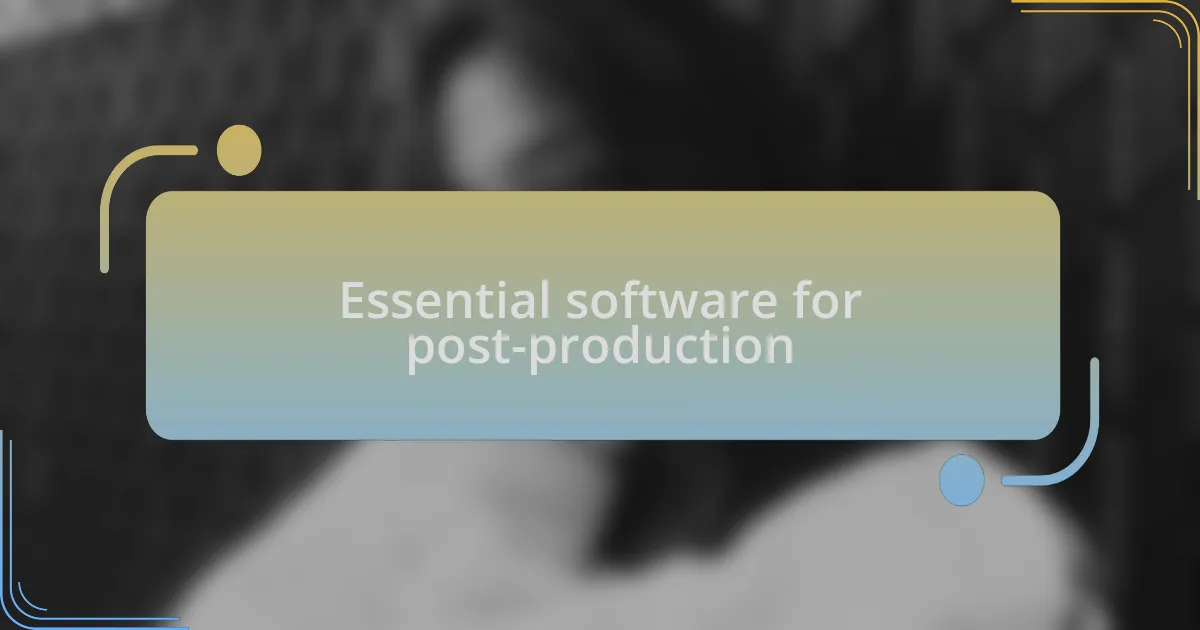
Essential software for post-production
When it comes to essential software for post-production, Adobe Premiere Pro stands out as a must-have in my toolkit. I remember the first time I used it; the intuitive interface allowed me to dive right into editing without feeling overwhelmed. The seamless integration with other Adobe products, like After Effects and Audition, means I can create stunning visual effects and fine-tune audio—all while maintaining a cohesive workflow. Isn’t it great when tools work hand-in-hand to spark creativity?
DaVinci Resolve is another powerhouse that I can’t emphasize enough. Its color grading capabilities changed my perspective on visual storytelling. I once spent hours tweaking a short film until the colors not only matched my vision but also enriched the narrative. Watching the transformation unfold on-screen, I couldn’t help but feel a rush. Have you ever witnessed your footage come to life through color? It’s an experience that I believe every filmmaker should embrace.
Finally, I find Final Cut Pro becomes an essential tool once I get more familiar with post-production. Its magnetic timeline lets me manipulate clips in unique ways, which I found especially useful during a project that demanded unconventional storytelling. I distinctly recall the tension of rearranging scenes until each moment perfectly aligned. It makes me wonder, how does the right software change our approach to storytelling? In my experience, the right tools can turn a good film into a great one.
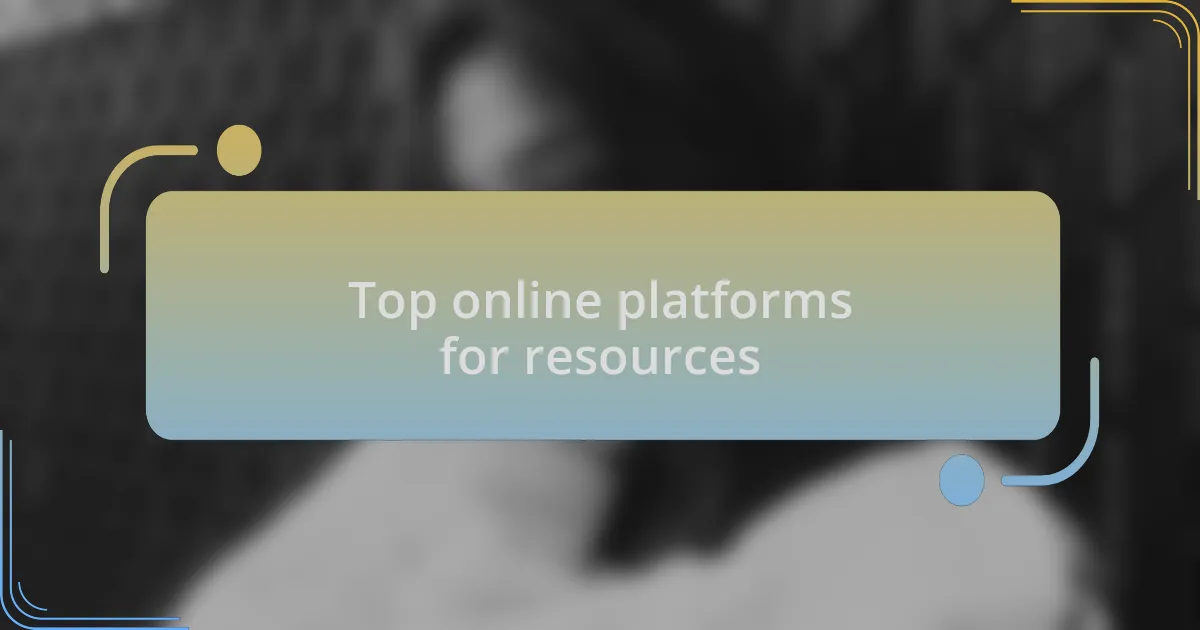
Top online platforms for resources
When it comes to sourcing assets, I often turn to platforms like Artgrid for high-quality stock footage. The first time I browsed through their library, I was amazed by the vast selection and how it complements my own filming style. Have you ever stumbled upon a clip that perfectly encapsulated the emotion you’re trying to convey? It’s a game-changer when you realize that such resources can elevate your project to new heights.
Another platform that truly enhances my workflow is AudioJungle, especially when I need unique soundtracks. I vividly recall working late into the night, searching for that perfect score to match a pivotal scene. The relief I felt when I found a track that resonated with the visual was indescribable! It makes you think—how crucial is the right audio in film? For me, it’s essential; the sound really does shape the entire experience of the viewer.
Lastly, I can’t overlook the value of forums like IndieTalk or Film Riot’s community where filmmakers share their insights and resources. I remember feeling nervous as a newbie, but the supportive environment was so refreshing. Have you ever felt like you belonged to a group where everyone shares the same passion? It’s those interactions that not only equip you with knowledge but also ignite your creative spirit.
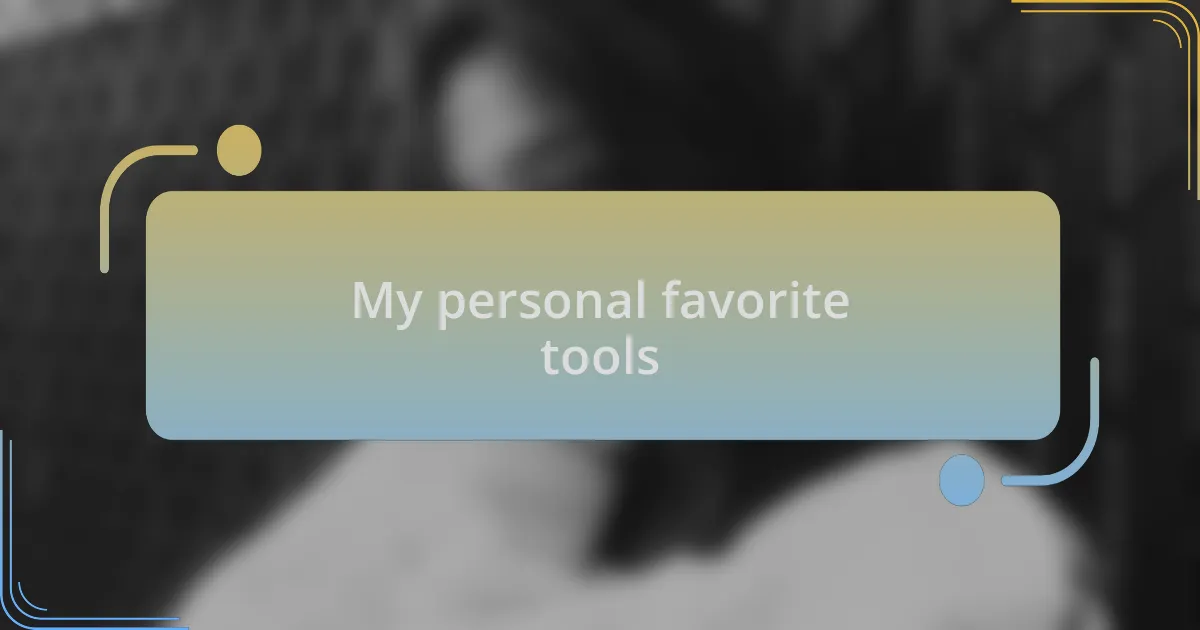
My personal favorite tools
One tool that I constantly keep in my post-production toolkit is Adobe Premiere Pro. I still remember the first time I navigated its interface; it felt overwhelming yet exhilarating at the same time. Have you ever felt like you’ve unlocked a new superpower? The ability to manipulate footage and audio seamlessly has transformed how I tell stories. Whether I’m cutting together a fast-paced montage or fine-tuning color grades, Premiere Pro adapts to my needs, making every project feel uniquely mine.
Another of my favorites is DaVinci Resolve, particularly for color correction. I never realized how vital color grading was until I started experimenting with it. There’s something magical about watching a bland scene come alive with vibrancy and depth. Does it ever surprise you how a few tweaks can change the entire mood of a film? I remember one specific project where a small adjustment in hue turned a good scene into an emotionally charged moment. It’s like having a canvas at my fingertips.
Lastly, I can’t underestimate the power of external hard drives like the ones from LaCie. Running out of storage is a filmmaker’s nightmare, and I learned that the hard way during a project. When my laptop almost crashed due to overflowing files, I had to scramble for a solution. It was stressful, but once I invested in reliable storage, my workflow became smoother. Have you ever felt like your creativity was stifled by technical issues? Having the right tools can truly free us to focus on what we love most: storytelling.
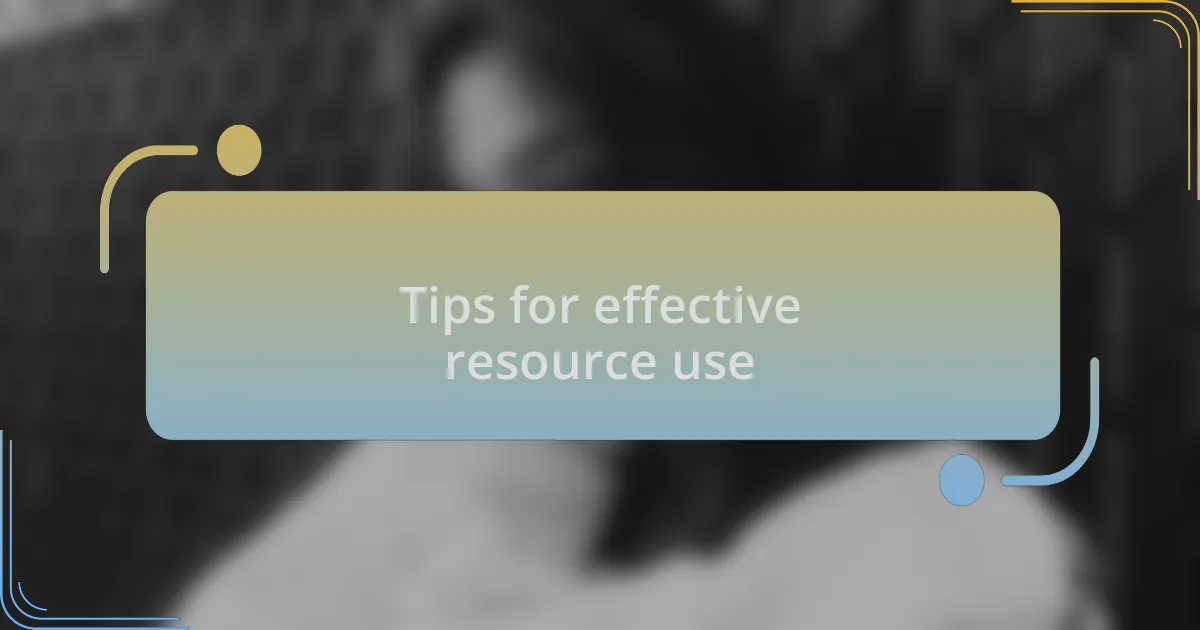
Tips for effective resource use
Utilizing resources effectively often comes down to organization. I remember a time when I tackled a project without a clear plan, jumping from one tool to another haphazardly. It was chaotic! Since then, I’ve learned that categorizing my tools and assets into folders and playlists can save me time and reduce stress. How many times have you wasted precious hours searching for that one sound clip or footage? Keeping things organized empowers you to focus on the creative process instead of getting lost in a maze of files.
Another vital tip is to invest in learning. I often wonder how much more I could accomplish if I took the time to master each tool. For instance, during a slow season, I dedicated a few hours each week to online tutorials for Premiere Pro and DaVinci Resolve. This investment in skill development not only enhanced my technical capabilities but also ignited my passion. Have you ever experienced that exhilarating feeling of mastering something new?
Lastly, collaboration can be a game-changer in post-production. I vividly recall working on a documentary where I partnered with a sound designer. Their expertise brought a depth to the audio that I had never achieved alone. It made me realize that sometimes, sharing your resources can elevate your work to unforeseen heights. Don’t you think that sharing knowledge and skills can lead to richer storytelling? Embracing collaboration broadened my horizons and taught me the value of diverse insights in film production.